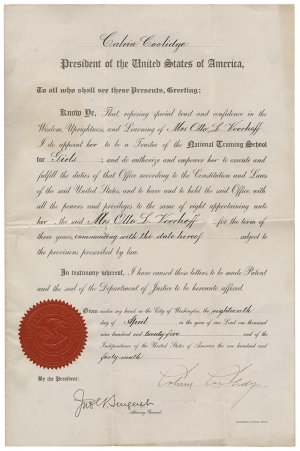|
Calvin Coolidge Appoints Trustee of the National Training School for Girls |
Click to enlarge:

President Calvin Coolidge reappoints Amy Louise Veerhoff as a member of the Board of Trustees of the National Training School for Girls. Originally appointed by President Warren G. Harding, Veerhoff served as president of the Board of Trustees for several years.
CALVIN COOLIDGE.
Partially Printed Document Signed, April 18, 1925, Washington, DC. Appointment of Mrs. Otto L. Veerhoff as Trustee of the National Training School for Girls. Countersigned by U.S. Attorney General John G. Sargent (1860-1939); includes a
“Department of Justice” red embossed seal. 1 p., 10½ x 16 in.
Inventory #26525
Price: $1,500
Historical Background
In 1888, Congress created the Reform School for Girls of the District of Columbia, and the name was changed to the National Training School for Girls in 1912. It was overseen by the Department of Justice and funded by Congressional appropriations. A six-member Board of Trustees oversaw the institution. In 1922-1923, Amy Louise Veerhoff served as president of the Board, consisting of two men and four women.
The National Training School for Girls accepted both white and black inmates, including unwed mothers. Congress considered the school to be a correctional facility rather than a charity, because of its mission to rehabilitate “wayward” girls.
President Veerhoff stated in a report submitted to the Board of Charities of the District of Columbia in 1923 that “the number of girls in the school June 30, 1923, was 56. During the year 40 were admitted, 39 reinstated, 16 discharged, 62 paroled, 50 escaped, and 1 died while on parole. The average daily number in the school was 60; the highest number at any one time being 106, the lowest, 49….” She also reported that at present there were at the school “four colored babies with their mothers. Formerly the practice has been to take the child from the mother upon her return to the school, thus relieving her of all further responsibility and knowledge of the child. This custom we have discontinued, believing that the child kept with the mother is the greatest means for the social reinstatement of the mother.” The Board asked for $10,000 in 1925 for repairs and remodeling, including a plan to rewire Washington Cottage, “which has already been declared dangerous” and providing “an automatic system for the release of all bedroom doors in case of fire, which has been recommended for years as a grave necessity.” She also reported that Superintendent Mrs. Morse had resigned to accept a position in New York at thrice the salary and that Miss Altona F. Gales from Boston had accepted the post of superintendent.[1]
In 1936, Carrie Weaver Smith became the new superintendent of the National Training School for Girls. When she arrived, she was horrified to find a decrepit facility operated with cruelty and filled with mostly African American inmates. Her tenure lasted only twenty months, in which she enacted a broad system of reforms, and enlisted the aid of First Lady Eleanor Roosevelt. When Smith invited members of Congress to visit, they demanded reforms. In 1936 and 1937, the Works Progress Administration conducted extensive renovations of the five buildings at the National Training School for Girls. However, two outbreaks of racial violence among girls at the school led the District of Columbia Board of Public Welfare to fire Smith. Despite hearings on her tenure in May and June 1939, the Board upheld her dismissal and returned to earlier punitive policies. Black girls at the National Training School continued to receive poor education in decaying buildings until the facility was finally closed in 1953.
Calvin Coolidge (1872-1933) was born in Vermont and graduated from Amherst College in 1895. An attorney by profession, Coolidge served in the state House of Representatives as a Republican from 1907 to 1908, then in the Massachusetts Senate from 1912-1915, the latter year as its president. From 1916 to the beginning of 1919, he served as lieutenant governor under Governor Samuel W. McCall, then succeeded McCall as governor of Massachusetts from 1919 to 1921. From 1921 until President Warren G. Harding’s unexpected death on August 2, 1923, Coolidge served as vice president. He succeeded Harding as president and won reelection in 1924. Coolidge’s presidency was marked by rapid economic growth. As a committed federalist and former governor, Coolidge believed many regulatory and other functions belonged to state and local governments, and he kept federal spending low. After leaving the Presidency in March 1929, Coolidge returned to Massachusetts and wrote his memoirs.
Amy Louise Warn Veerhoff (1879-1936) was born in Fort Scott, Kansas, to Gilbert Samuel Warn and Amy Anna Gunn Warn. She attended Lake Erie College and Vassar College before graduating with a bachelor’s degree from George Washington University. She was an English teacher at the McKinley Manual training school from 1903 to 1906. In 1906, she married Otto Louis Veerhoff (1883-1952), who became the proprietor of the Veerhoff Art Gallery in Washington, D.C., and they had three children. President Warren G. Harding appointed her to the Board of Trustees of the National Training School for Girls, and President Calvin Coolidge reappointed her. She served as the President of the Board of Trustees of the National Training School for Girls, 1922-1923, and on a variety of other clubs in Takoma Park, Maryland, a suburb of Washington, D.C.
Condition: Inner pages are blank; expected paper folds; faint ghost impressions corresponding to the seal and one of the signatures; unevenly toned along the edges of the first page; expected weathering on the last page where it was folded.